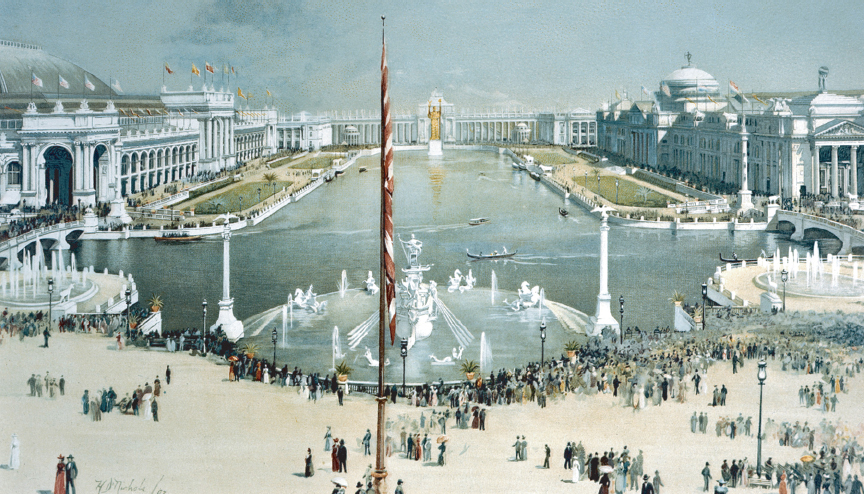White City or City of Sin?
Printed Page 572
Americans have always been of two minds about the city. They like to boast of its skyscrapers and bridges, its culture and sophistication, and they pride themselves on its bigness and bustle. At the same time, they fear it as the city of sin, the home of immigrant slums, the center of vice and crime. Nowhere did the divided view of the American city take form more graphically than in Chicago in 1893. In that year, Chicago hosted the World's Columbian Exposition, the grandest world’s fair in the nation’s history. The fairground, only five miles down the shore of Lake Michigan from downtown Chicago, offered a lesson in what Americans on the eve of the twentieth century imagined a city might be. Christened the “White City,” the fairground seemed light-years away from Chicago, with its stockyards, slums, and bustling terminals. Frederick Law Olmsted and architect Daniel Burnham supervised the transformation of a swampy wasteland into a pristine paradise of lagoons, fountains, wooded islands, gardens, and imposing white buildings.
 World’s fair held in Chicago in 1893 that attracted millions of visitors. The elaborately designed pavilions of the “White City” included exhibits of technological innovation and of cultural exoticism. The white buildings embodied an urban ideal that contrasted with the realities of Chicago life.
World’s fair held in Chicago in 1893 that attracted millions of visitors. The elaborately designed pavilions of the “White City” included exhibits of technological innovation and of cultural exoticism. The white buildings embodied an urban ideal that contrasted with the realities of Chicago life.

“Sell the cookstove if necessary and come,” novelist Hamlin Garland wrote to his parents on the farm. And come they did, in spite of the panic and depression that broke out only weeks after the fair opened in May 1893. In six months, fairgoers purchased more than 27 million tickets, turning a profit of nearly half a million dollars for promoters. Visitors from home and abroad strolled the elaborate grounds and visited the exhibits — everything from a model of the Brooklyn Bridge carved in soap to the latest goods and inventions. Half carnival, half culture, the great fair offered something for everyone. On the Midway Plaisance, crowds thrilled to the massive wheel built by G. W. G. Ferris and watched agog as Little Egypt danced the hootchy-kootchy.
In October, the fair closed its doors in the midst of the worst depression the country had yet seen. During the winter of 1894, Chicago’s unemployed and homeless took over the grounds, vandalized the buildings, and frightened the city’s comfortable citizens out of their wits. When reporters asked Daniel Burnham, its chief architect, what should be done with the moldering remains of the White City, he responded, “It should be torched.” And it was. In July 1894, in a clash between federal troops and striking railway workers, incendiaries set fires that leveled the fairgrounds.
CHAPTER LOCATOR
Why did American cities experience explosive growth in the late nineteenth century?
What kinds of work did people do in industrial America?
Why did the fortunes of the Knights of Labor rise in the late 1870s and decline in the 1890s?
How did urban industrialism shape home life and the world of leisure?
How did municipal governments respond to the challenges of urban expansion?
Conclusion: Who built the cities?
 LearningCurve
LearningCurve
Check what you know.
In the end, the White City remained what it had always been, a dreamscape. Buildings that looked like marble were actually constructed of staff, a plaster substance that began to crumble even before fire destroyed the fairgrounds. Perhaps it was not so strange, after all, that the legacy of the White City could be found on Coney Island, where two new amusement parks, Luna and Dreamland, sought to combine, albeit in a more tawdry form, the beauty of the White City and the thrill of the Midway Plaisance. More enduring than the White City itself was what it represented: the emergent industrial might of the United States, at home and abroad, with its inventions, manufactured goods, and growing consumer culture.
QUICK REVIEW
Question
How did city life change in the late nineteenth century?